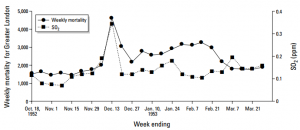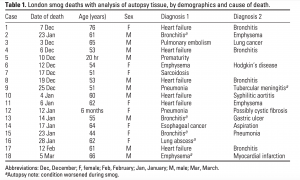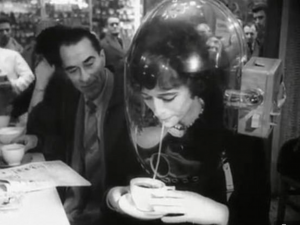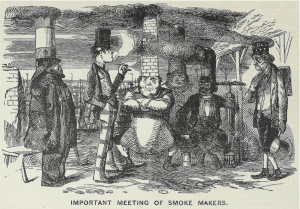
There are two pieces to the story of The Great Smog that are interlocked together; the health implications from the smog, and the government’s actions. The eldest members of the London community in 1952 were hit the hardest by The Great Smog in terms of health implications. The average number of weekly deaths for the 0- to 25-year-old group rose from 46 (weekly average) in November to 74 at the height of the episode (for the week ending 13 December 1952). In comparison, the increase in mortality for individuals more than 75 years old was from 477 to 1,666(9).
 Most of the deaths were caused by respiratory tract infections from hypoxia and as a result of mechanical obstruction of the air passages by pus arising from lung infections caused by the smog. Table 1. is a compilation of death autopsies in different demographics and the causes of death. The majority of people died due to bronchopneumonia or acute purulent bronchitis superimposed upon chronic bronchitis(18).
Most of the deaths were caused by respiratory tract infections from hypoxia and as a result of mechanical obstruction of the air passages by pus arising from lung infections caused by the smog. Table 1. is a compilation of death autopsies in different demographics and the causes of death. The majority of people died due to bronchopneumonia or acute purulent bronchitis superimposed upon chronic bronchitis(18).
At the end of The Great Smog, a report was released (was later recounted) that around 12,000 people died in The Great Smog episode. Within the same month of that publication, the people who wrote the report had to rescind it because the government only wanted people who had died during the actual week of the fog to be counted.

This feeble attempt to mask the true gravity of the disaster angered many people, and later scientists proved that the number was far beyond 12,000 when they included people who died later in life due to lung issues rather than the meager 3,500-4,000 people the government claimed to have died. The Ministry of Health also tried to hide the fact that the pollution killed so many by saying that 5,655 had died of influenza in the first three months of 1953. This was a complete and utter fabrication to hide the many deaths caused by smog. This is not the only time the government feigned ignorance during this disaster. In fact, many say that the government did not do its job in protecting its people adequately, and they are in part to blame for this disaster.
 Political figures decided to try to have an adaptive response to the disaster rather than a mitigative one. The government started setting up booths all over the city where people could go and grab a mask, which was supposed to protect them from the smog. Some companies sold expensive and elaborate masks to those who could afford it claiming that it would protect them, and some people even got masks for their pets.
Political figures decided to try to have an adaptive response to the disaster rather than a mitigative one. The government started setting up booths all over the city where people could go and grab a mask, which was supposed to protect them from the smog. Some companies sold expensive and elaborate masks to those who could afford it claiming that it would protect them, and some people even got masks for their pets.  Farmers noticed that cattle kept choking to death on the toxic fumes in Smithfield, so they attempted to fashion gas masks for their cows by soaking grain sacks in whiskey but saw little success(18).
Farmers noticed that cattle kept choking to death on the toxic fumes in Smithfield, so they attempted to fashion gas masks for their cows by soaking grain sacks in whiskey but saw little success(18).
Later, it was realized that in this specific case, masks were a complete hoax that governmental figures pretended would work to keep citizens calm, plus, it was cheaper to give out ineffective masks than to make real, feasible changes. They were something easy that the government could advise its citizens to wear without spending too much money. The government was trying to wiggle its way around providing substantial support to hospitals, and failing to make changes to the laws regarding the burning of coal. The reason behind this ineffectiveness was because Great Britain was bankrupt and they were trying to hide it. At the time, they did not want to reallocate money into this disaster because they felt it would be better spent elsewhere.

Though some sources disagreed, most Historians tie the failures of the government to Harold MacMillan. The show The Crown portrayed Winston Churchill as the main villain in the smog event, but really MacMillan, the housing Minister at the time, was much more to blame. MacMillan was given a warning from a small town in Pennsylvania where a similar fog had occurred just years before. 100s of people died, and a cautionary message was sent to places that could face a similar catastrophe. MacMillan decided to ignore the report, and when the fog inevitably occurred, he unceremoniously chalked it up to being a “weather event”.  He continued on with a business as usual attitude, doing anything possible to avoid further devastating their already broken economy. It ended up taking the government 4 years to create the Clean Air Act of 1956 in order to counteract the pollution and damage that was caused. Beyond the initial deaths of that first month, there were also plenty of long term issues such as Asthma that scientists have directly linked to air pollution events like the Great Smog.
He continued on with a business as usual attitude, doing anything possible to avoid further devastating their already broken economy. It ended up taking the government 4 years to create the Clean Air Act of 1956 in order to counteract the pollution and damage that was caused. Beyond the initial deaths of that first month, there were also plenty of long term issues such as Asthma that scientists have directly linked to air pollution events like the Great Smog.
